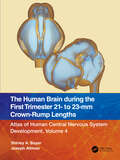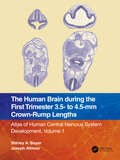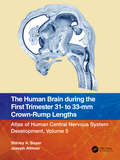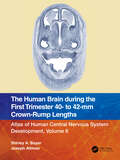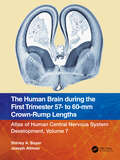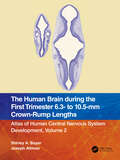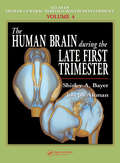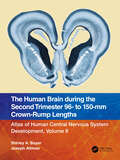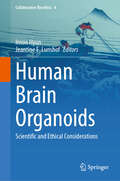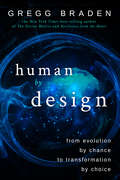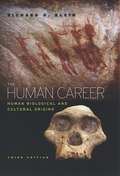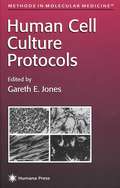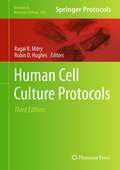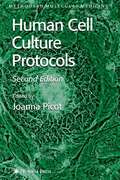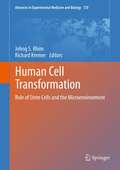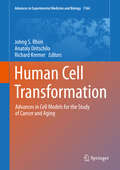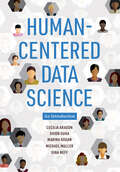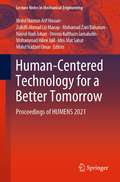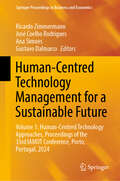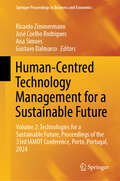- Table View
- List View
The Human Brain during the First Trimester 21- to 23-mm Crown-Rump Lengths: Atlas of Human Central Nervous System Development, Volume 4
by Shirley A. Bayer Joseph AltmanThis fourth of 15 short atlases reimagines the classic 5-volume Atlas of Human Central Nervous System Development. This volume presents serial sections from specimens between 21 mm and 23 mm with detailed annotations, together with 3D reconstructions. An introduction summarizes human CNS development by using high-resolution photos of methacrylate-embedded rat embryos at a similar stage of development as the human specimens in this volume. The accompanying Glossary gives definitions for all the terms used in this volume and all the others in the Atlas. Key Features Classic anatomical atlases Detailed labeling of structures in the developing brain offers updated terminology and the identification of unique developmental features, such as, germinal matrices of specific neuronal populations and migratory streams of young neurons Appeals to neuroanatomists, developmental biologists, and clinical practitioners. A valuable reference work on brain development that will be relevant for decades
The Human Brain during the First Trimester 3.5- to 4.5-mm Crown-Rump Lengths: Atlas of Human Central Nervous System Development, Volume 1
by Shirley A. Bayer Joseph AltmanThis first of 15 short atlases reimagines the classic 5-volume Atlas of Human Central Nervous System Development. This volume presents serial sections from specimens between 3.5 mm and 4.5 mm with detailed annotations, together with 3D reconstructions. An introduction summarizes human CNS development by using high-resolution photos of methacrylate-embedded rat embryos at a similar stage of development as the human specimens in this volume. The accompanying Glossary gives definitions for all the terms used in this volume and all the others in the Atlas. Features Classic anatomical atlas Detailed labeling of structures in the developing brain offers updated terminology and the identification of unique developmental features, such as germinal matrices of specific neuronal populations and migratory streams of young neurons Appeals to neuroanatomists, developmental biologists, and clinical practitioners A valuable reference work on brain development that will be relevant for decades
The Human Brain during the First Trimester 31- to 33-mm Crown-Rump Lengths: Atlas of Human Central Nervous System Development, Volume 5
by Shirley A. Bayer Joseph AltmanThis fifth of 15 short atlases reimagines the classic 5-volume Atlas of Human Central Nervous System Development. This volume presents serial sections from specimens between 31 mm and 33 mm with detailed annotations, together with 3D reconstructions. An introduction summarizes human CNS development by using high-resolution photos of methacrylate-embedded rat embryos at a similar stage of development as the human specimens in this volume. The accompanying Glossary gives definitions for all the terms used in this volume and all the others in the Atlas. Features Classic anatomical atlases Detailed labeling of structures in the developing brain offers updated terminology and the identification of unique developmental features, such as, germinal matrices of specific neuronal populations and migratory streams of young neurons Appeals to neuroanatomists, developmental biologists, and clinical practioners A valuable reference work on brain development that will be relevant for decades
The Human Brain during the First Trimester 40- to 42-mm Crown-Rump Lengths: Atlas of Human Central Nervous System Development, Volume 6
by Shirley A. Bayer Joseph AltmanThis sixth of 15 short atlases reimagines the classic 5-volume Atlas of Human Central Nervous System Development. This volume presents serial sections from specimens between 40 mm and 42 mm with detailed annotations, together with 3D reconstructions. An introduction summarizes human CNS development by using high-resolution photos of methacrylate-embedded rat embryos at a similar stage of development as the human specimens in this volume. The accompanying Glossary gives definitions for all the terms used in this volume and all the others in the Atlas. Features Classic anatomical atlas Detailed labeling of structures in the developing brain offers updated terminology and the identification of unique developmental features, such as, germinal matrices of specific neuronal populations and migratory streams of young neurons Appeals to neuroanatomists, developmental biologists, and clinical practitioners A valuable reference work on brain development that will be relevant for decades
The Human Brain during the First Trimester 57- to 60-mm Crown-Rump Lengths: Atlas of Human Central Nervous System Development, Volume 7
by Shirley A. Bayer Joseph AltmanThe seventh of 15 short atlases reimagining the classic 5-volume Atlas of Human Central Nervous System Development. This volume presents serial sections from specimens between 57 mm and 60 mm with detailed annotations, together with 3D reconstructions. An introduction summarizes human CNS development by using high-resolution photos of methacrylate-embedded rat embryos at a similar stage of development as the human specimens in this volume. The accompanying Glossary gives definitions for all the terms used in this volume and all the others in the Atlas. Features • Classic anatomical atlas • Detailed labeling of structures in the developing brain offers updated terminology and the identification of unique developmental features, such as, germinal matrices of specific neuronal populations and migratory streams of young neurons • Appeals to neuroanatomists, developmental biologists, and clinical practitioners • A valuable reference work on brain development that will be relevant for decades
The Human Brain during the First Trimester 6.3- to 10.5-mm Crown-Rump Lengths: Atlas of Human Central Nervous System Development, Volume 2
by Shirley A. Bayer Joseph AltmanThis second of 15 short atlases reimagines the classic 5-volume Atlas of Human Central Nervous System Development. This volume presents serial sections from specimens between 6.3 mm and 10.5 mm with detailed annotations, together with 3D reconstructions. An introduction summarizes human CNS development by using high-resolution photos of methacrylate-embedded rat embryos at a similar stage of development as the human specimens in this volume. The accompanying Glossary gives definitions for all the terms used in this volume and all the others in the Atlas. Features Classic anatomical atlas Detailed labeling of structures in the developing brain offers updated terminology and the identification of unique developmental features, such as, germinal matrices of specific neuronal populations and migratory streams of young neurons Appeals to neuroanatomists, developmental biologists, and clinical practitioners A valuable reference work on brain development that will be relevant for decades
The Human Brain During the Late First Trimester
by Shirley A. Bayer Joseph AltmanThe fourth volume in the Atlas of Human Central Nervous System Development series, The Human Brain During the Late First Trimester provides new information about features of the perinatal brain. It deals with brain development during the late first trimester (GW11-GW7.5). The major theme of this volume is the identification of stretches and patches
The Human Brain during the Second Trimester 160– to 170–mm Crown-Rump Lengths: Atlas of Human Central Nervous System Development, Volume 9
by Shirley A. Bayer Joseph AltmanThis ninth of 15 short atlases reimagines the classic 5-volume Atlas of Human Central Nervous System Development. This volume presents serial sections from specimens between 160 mm and 170 mm with detailed annotations. An introduction summarizes human CNS developmental highlights around 5 months of gestation. The Glossary (available separately) gives definitions for all the terms used in this voume and all the others in the Atlas. Features • Classic anatomical atlas • Detailed labeling of structures in the developing brain offers updated terminology and the identification of unique developmental features, such as germinal matrices of specific neuronal populations and migratory streams of young neurons • Appeals to neuroanatomists, developmental biologists, and clinical practitioners • A valuable reference work on brain development that will be relevant for decades
The Human Brain during the Second Trimester 190– to 210–mm Crown-Rump Lengths: Atlas of Human Central Nervous System Development, Volume 10
by Shirley A. Bayer Joseph AltmanThis tenth of 15 short atlases reimagines the classic 5-volume Atlas of Human Central Nervous System Development. This volume presents serial sections from specimens between 190 mm and 210 mm with detailed annotations. An introduction summarizes human CNS developmental highlights around 5 months of gestation. The Glossary (available separately) gives definitions for all the terms used in this volume and all the others in the Atlas. Features • Classic anatomical atlas • Detailed labeling of structures in the developing brain offers updated terminology and the identification of unique developmental features, such as germinal matrices of specific neuronal populations and migratory streams of young neurons • Appeals to neuroanatomists, developmental biologists, and clinical practitioners • A valuable reference work on brain development that will be relevant for decades
The Human Brain during the Second Trimester 96– to 150–mm Crown-Rump Lengths: Atlas of Human Central Nervous System Development, Volume 8
by Shirley A. Bayer Joseph AltmanThis eighth of 15 short atlases reimagines the classic 5-volume Atlas of Human Central Nervous System Development. This volume presents serial sections from specimens between 96 mm and 150 mm with detailed annotations. An introduction summarizes human CNS developmental highlights between 3.5 and 4.5 months of gestation. The accompanying Glossary (available free online) gives definitions for all the labels used in this volume and all the others in the Atlas. Key Features • Classic anatomical atlas • Detailed labeling of structures in the developing brain offers updated terminology and the identification of unique developmental features such as germinal matrices of specific neuronal populations and migratory streams of young neurons • Appeals to neuroanatomists, developmental biologists, and clinical practitioners • A valuable reference work on brain development that will be relevant for decades
The Human Brain during the Third Trimester 225– to 235–mm Crown-Rump Lengths: Atlas of Central Nervous System Development, Volume 11
by Shirley A. Bayer Joseph AltmanThis eleventh of 15 short atlases reimagines the classic 5-volume Atlas of Human Central Nervous System Development. This volume presents serial sections from specimens between 225 mm and 235 mm with detailed annotations. An introduction summarizes human CNS developmental highlights around 6.5 months of gestation. The Glossary (available separately) gives definitions for all the terms used in this volume and all the others in the Atlas. Key Features • Classic anatomical atlases • Detailed labeling of structures in the developing brain offers updated terminology and the identification of unique developmental features, such as germinal matrices of specific neuronal populations and migratory streams of young neurons • Appeals to neuroanatomists, developmental biologists, and clinical practitioners • A valuable reference work on brain development that will be relevant for decades
The Human Brain during the Third Trimester 260– to 270–mm Crown-Rump Lengths: Atlas of Central Nervous System Development, Volume 12
by Shirley A. Bayer Joseph AltmanThis twelfth of 15 short atlases reimagines the classic 5-volume Atlas of Human Central Nervous System Development. This volume presents serial sections from specimens between 260 mm and 270 mm with detailed annotations. An introduction summarizes human CNS developmental highlights around 6.5 months of gestation. The Glossary (available separately) gives definitions for all the terms used in this volume and all the others in the Atlas. Key Features • Classic anatomical atlases • Detailed labeling of structures in the developing brain offers updated terminology and the identification of unique developmental features, such as germinal matrices of specific neuronal populations and migratory streams of young neurons • Appeals to neuroanatomists, developmental biologists, and clinical practitioners • A valuable reference work on brain development that will be relevant for decades
The Human Brain during the Third Trimester 310– to 350–mm Crown-Rump Lengths: Atlas of Central Nervous System Development, Volume 13
by Shirley A. Bayer Joseph AltmanThis thirteenth of 15 short atlases reimagines the classic 5 volume Atlas of Human Central Nervous System Development. This volume presents serial sections from specimens between 310 mm and 350 mm with detailed annotations. An introduction summarizes human CNS developmental highlights around 9 months of gestation. The Glossary (available separately) gives definitions for all the terms used in this volume and all the others in the Atlas. Key Features • Classic anatomical atlases • Detailed labeling of structures in the developing brain offers updated terminology and the identification of unique developmental features, such as germinal matrices of specific neuronal populations and migratory streams of young neurons • Appeals to neuroanatomists, developmental biologists, and clinical practitioners • A valuable reference work on brain development that will be relevant for decades
Human Brain Organoids: Scientific and Ethical Considerations (Collaborative Bioethics #4)
by Insoo Hyun Jeantine E. LunshofBrain organoids are small stem cell-derived, self-organizing models of specific brain regions that offer researchers new ways to study the human brain. Since their scientific debut over ten years ago, brain organoids have been used to generate tractable new bioengineered tools for understanding functional interconnectivity of the human brain, dysfunction involved in many neurodegenerative diseases, and certain molecular mechanisms underlying cognition. Despite this field’s considerable scientific promise, advances in human brain organoid research also raise novel philosophical questions and ethical concerns around the use of complex human brain models and the ethical boundaries that should exist when manipulating increasingly realistic bioengineered brain constructs. As researchers generate more realistic organoids in vitro that resemble human brains, it is critically important to understand what ethical boundaries may exist and where researchers and regulators should draw the line for research, both to reduce uncertainties over which projects to pursue in the lab and to address future concerns regulators and the public may harbor about whether this research, if left unexamined, could inadvertently undermine public trust in science. This proposed book delves into ongoing and proactive ethical discussions among ethicists and the neuroscientists involved with this cutting-edge work. Its ultimate goal is to foster greater awareness, understanding, and guidance for future management of ethical issues that may be unique to new areas of brain organoid research. This volume is the result of a close partnership between ethicists and scientists, each informing the other through a collaborative process of joint bioethical deliberation.
Human by Design: From Evolution by Chance to Transformation by Choice
by Gregg BradenHuman by Design invites you on a journey beyond Darwin’s theory of evolution, beginning with the fact that we exist as we do, even more empowered, and more connected with ourselves and the world, than scientists have believed possible.In one of the great ironies of the modern world, the science that was expected to solve life’s mysteries has done just the opposite. New discoveries have led to more unanswered questions, created deeper mysteries, and brought us to the brink of forbidden territory when it comes to explaining our origin and existence. These discoveries reveal the following facts: • Fact 1. Our origin —Modern humans appeared suddenly on earth approximately 200,000 years ago, with the advanced brain, nervous system, and capabilities that set them apart from all other known forms of life already developed, rather than having developed slowly and gradually over a long periods of time. • Fact 2. Missing physical evidence —The relationships shown on the conventional tree of human evolution are speculative connections only. While they are believed to exist, a 150-year search has failed to produce the physical evidence that confirms the relationships shown on the evolutionary family tree. • Fact 3. New DNA evidence —The comparison of DNA between ancient Neanderthals, previously thought to be our ancestors, and early humans tells us that we did not descend from the Neanderthals. • Fact 4. A rare DNA fusion —Advanced genome analysis reveals that the DNA that sets us apart from other primates, including in our advanced brain and nervous system, is the result of an ancient and precise fusion of genes occurring in a way that suggests something beyond evolution made our humanness possible. • Fact 5. Our extraordinary abilities —We are born with the capacity to self-heal, to self-regulate longevity, to activate an enhanced immune response, and to experience deep intuition, sympathy, empathy, and, ultimately, compassion —and to do each of these on demand.In this book, New York Times best-selling author and 2017 Templeton Award nominee Gregg Braden crosses the traditional boundaries of science and spirituality to answer the timeless question at the core of our existence —Who are we? —and to reveal science-based techniques that awaken our uniquely human experiences of deep intuition, precognition, advanced states of self-healing, and much more! Beyond any reasonable doubt, Human by Design reveals that we’re not what we’ve been told, and much more than we’ve ever imagined.
The Human Career: Human Biological and Cultural Origins (3rd edition)
by Richard G. KleinKlein (anthro, U. of Chicago) summarizes our current knowledge and ongoing debates about human evolution from the earliest primates to modern man. Both the fossil and archaeological evidence is examined, showing the relationship between human form and behavior.
Human Cell Culture Protocols
by Gareth E. JonesExpert scientific and clinical investigators present proven human cell culture techniques applicable to tissue samples taken from a wide variety of organs, particularly those prone to pathological change. They describe in clear, step-by-step instructions the special requirements for successfully culturing such human cells as T-cells, trophoblast cells, renal cells, natural killer cells, endothelial cells, neurons, epithelial cells, pituitary cells, and more. The protocols eliminate much of the chore of adapting techniques initially developed for animal cell culture systems or the time spent in hunting down potentially useful techniques buried in the details of research papers, or even in books largely devoted to animal cell culture. They allow researchers to use successfully high quality in vitro cultures as models to explore the disease process.
Human Cell Culture Protocols
by Ragai R. Mitry Robin D. HughesHuman cell culture is not a new topic, but the development of new molecular techniques and reagents which can be used to investigate cell function and the responsible intracellular mechanisms make it a continuing requirement. This third edition of Human Cell Culture Protocols expands upon the previous editions with current, detailed protocols for the isolation and culture of a range of primary cells from human tissues. With new chapters on pancreatic cells needed for basic studies on the pathogenesis of diabetes and for their application for islet transplantation, the book also delves into protocols for hepatocytes, skin cells, lung cells, parathyroid cells, gastric cells, renal cells, adipocytes, ovarian cells, bone cells, vascular smooth muscle cells, vascular endothelial cells, regulatory T cells, blood mononuclear cells, as well as new techniques being applied to human cell culture, particularly the use of biocompatible scaffolds to grow cells, the in vitro use of laser microdissection to isolate cells from culture, and automated cell culture. Written in the highly successful Methods in Molecular BiologyTM series format, chapters include introductions to their respective topics, lists of the necessary materials and reagents, step-by-step, readily reproducible laboratory protocols, and tips on troubleshooting and avoiding known pitfalls. Authoritative and cutting-edge, Human Cell Culture Protocols, Third Edition makes it possible for a worker with basic cell culture training, whether in the fields of cell biology, gene therapy, and cell transplantation, to prepare cell cultures of the specific cell type necessary to forward their vital research.
Human Cell Culture Protocols
by Joanna PicotA thoroughly revised and updated collection readily reproducible techniques for culturing human cells. This new edition includes a wide range of human cell types relevant to human disease and new chapters on fibroblasts, Schwann cells, gastric and colonic epithelial cells, and parathyroid cells. The protocols follow the successful Methods in Molecular MedicineTM series format, each offering step-by-step laboratory instructions, an introduction outlining the principle behind the technique, lists of the necessary equipment and reagents, and tips on troubleshooting and avoiding known pitfalls.
Human Cell Transformation
by Richard Kremer Johng S. RhimRhim and Kremer's state-of-the-art volume on Human Cell Transformation: Role of Stem Cells and the Microenvironment highlights the latest findings on the current state of human cell transformation model systems and provides the insight into the molecular and cellular changes involved in the conversion of normal cells to neoplastic cells. Chapters cover all recently developed novel human cell models. In addition, the rapidly growing fields of knowledge regarding not only stem cells in cancer progression, but also the role of the microenvironments in human carcinogenesis are discussed. A wealth of topics is presented including: · Derivation of epithelial, fibroblastic, and hematopoietic in vitro model systems · Oncogenes · Tumor suppressor genes · Viral transformation · In vitro model systems for viral, chemical and radiation carcinogenesis · Cell aging · The multistep nature of human carcinogenesis · The role of stem cells and the microenvironment in tumorigenesis · The genes involved in multistep carcinogenesis Unique in both scope and focus - devoted solely to human cell transformation systems - Human Cell Transformation: Role of Stem Cells and the Microenvironment provides unparalleled, in-depth coverage for cancer researchers, cell and molecular biologists, hematologists, virologists, and workers in related fields. Essential reading for everyone who needs to be kept up-to-date in this fast-paced area! Features Ø Multistep models Ø Breast cancer/Stem cells Ø Prostate cancer/Stem cells Ø Multistep / Genes
Human Cell Transformation: Advances in Cell Models for the Study of Cancer and Aging (Advances in Experimental Medicine and Biology #1164)
by Johng S. Rhim Anatoly Dritschilo Richard KremerThis book, part contributed volume, part proceedings, discusses state-of-the-art advances on human cell transformation in cell models for the study of cancer and aging. Several of the chapters are from the Human Cell Transformation: Advances in Cell Models for the Study of Cancer and Aging conference that was held in June 2018 at McGill University. The authors represent international expertise on a wide variety of topics ranging from different types of cancer (prostate, bone, breast, etc.) to tumor microenvironment, tumor progression, homogeneity, and possible therapies and treatments.
Human-Centered Data Science: An Introduction
by Cecilia Aragon Shion Guha Marina Kogan Michael Muller Gina NeffBest practices for addressing the bias and inequality that may result from the automated collection, analysis, and distribution of large datasets.Human-centered data science is a new interdisciplinary field that draws from human-computer interaction, social science, statistics, and computational techniques. This book, written by founders of the field, introduces best practices for addressing the bias and inequality that may result from the automated collection, analysis, and distribution of very large datasets. It offers a brief and accessible overview of many common statistical and algorithmic data science techniques, explains human-centered approaches to data science problems, and presents practical guidelines and real-world case studies to help readers apply these methods. The authors explain how data scientists&’ choices are involved at every stage of the data science workflow—and show how a human-centered approach can enhance each one, by making the process more transparent, asking questions, and considering the social context of the data. They describe how tools from social science might be incorporated into data science practices, discuss different types of collaboration, and consider data storytelling through visualization. The book shows that data science practitioners can build rigorous and ethical algorithms and design projects that use cutting-edge computational tools and address social concerns.
Human-Centered Technology for a Better Tomorrow: Proceedings of HUMENS 2021 (Lecture Notes in Mechanical Engineering)
by Mohd Hasnun Arif Hassan Zulkifli Ahmad A Manap Mohamad Zairi Baharom Nasrul Hadi Johari Ummu Kulthum Jamaludin Muhammad Hilmi Jalil Idris Mat Sahat Mohd Nadzeri OmarThis book acts as a compilation of papers presented in the Human Engineering Symposium (HUMENS 2021). The symposium theme, “Human-centered Technology for A Better Tomorrow,” covers the following research topics: ergonomics, biomechanics, sports technology, medical device and instrumentation, artificial intelligence / machine learning, industrial design, rehabilitation, additive manufacturing, modelling and bio-simulation, and signal processing. Fifty-nine articles published in this book are divided into four parts, namely Part 1—Artificial Intelligence and Biosimulation, Part 2—Biomechanics, Safety and Sports, Part 3—Design and Instrumentation, and Part 4—Ergonomics.
Human-Centred Technology Management for a Sustainable Future: Volume 1: Human-Centred Technology Approaches, Proceedings of the 33rd IAMOT Conference, Porto, Portugal, 2024 (Springer Proceedings in Business and Economics)
by Ricardo Zimmermann José Coelho Rodrigues Ana Simoes Gustavo DalmarcoThis proceedings volume contains selected papers from the 33rd International Association for Management of Technology (IAMOT) Conference, held from July 8-11, 2024, in Porto, Portugal. It is the second volume of a three-volume set of conference proceedings focused on technologies for a sustainable future. The book explores the challenges and opportunities in today's social and business landscapes, delving into innovative and disruptive concepts. With a special emphasis on the role of technologies, it sheds light on how they enable novel approaches to address current issues. The volume demonstrates that, following the principles of Industry 5.0, technologies can go far beyond productivity and economic gains, contributing to the benefit and comfort of human workers. It also elucidates the necessity of adopting a human-centered approach in utilizing technology to adapt production processes to workers' needs, while ensuring that the implementation of new technologies does not infringe upon the fundamental rights of workers.
Human-Centred Technology Management for a Sustainable Future: Volume 2: Technologies for a Sustainable Future, Proceedings of the 33rd IAMOT Conference, Porto, Portugal, 2024 (Springer Proceedings in Business and Economics)
by Ricardo Zimmermann José Coelho Rodrigues Ana Simoes Gustavo DalmarcoThis proceedings volume contains selected papers from the 33rd International Association for Management of Technology (IAMOT) Conference, held from July 8-11, 2024, in Porto, Portugal. It is the second volume of a three-volume set of conference proceedings focused on technologies for a sustainable future. The book explores the challenges and opportunities in today's social and business landscapes, delving into innovative and disruptive concepts. With a special emphasis on the role of technologies, it sheds light on how they enable novel approaches to address current issues. The volume demonstrates that, following the principles of Industry 5.0, technologies can go far beyond productivity and economic gains, contributing to the benefit and comfort of human workers. It also elucidates the necessity of adopting a human-centered approach in utilizing technology to adapt production processes to workers' needs, while ensuring that the implementation of new technologies does not infringe upon the fundamental rights of workers.
